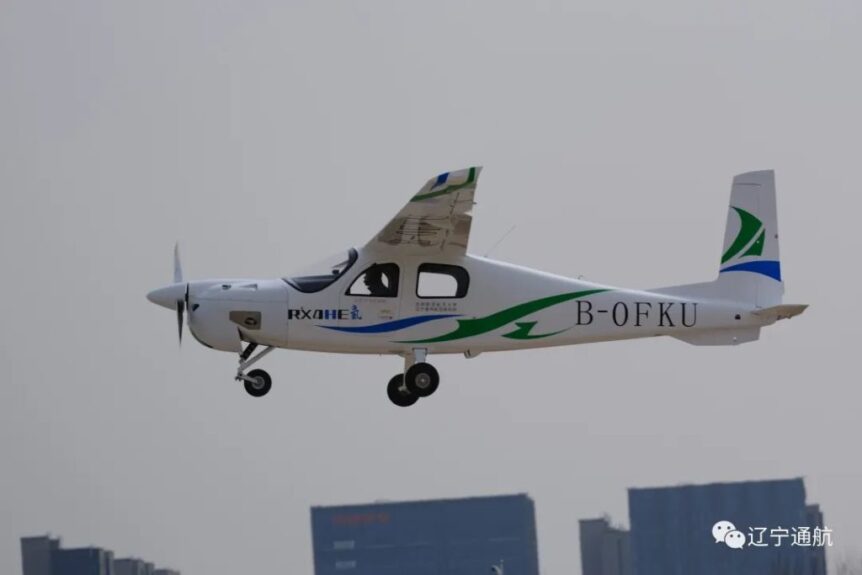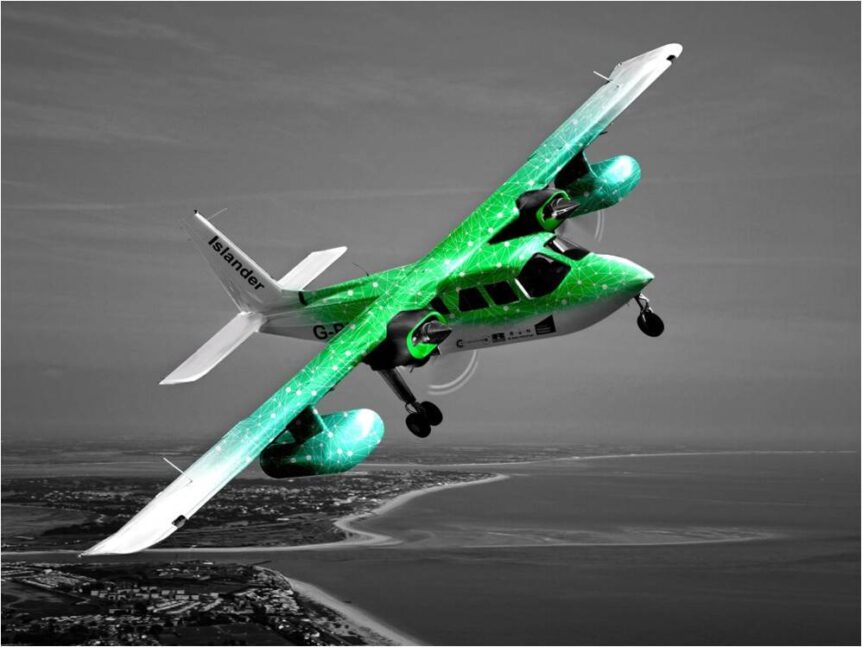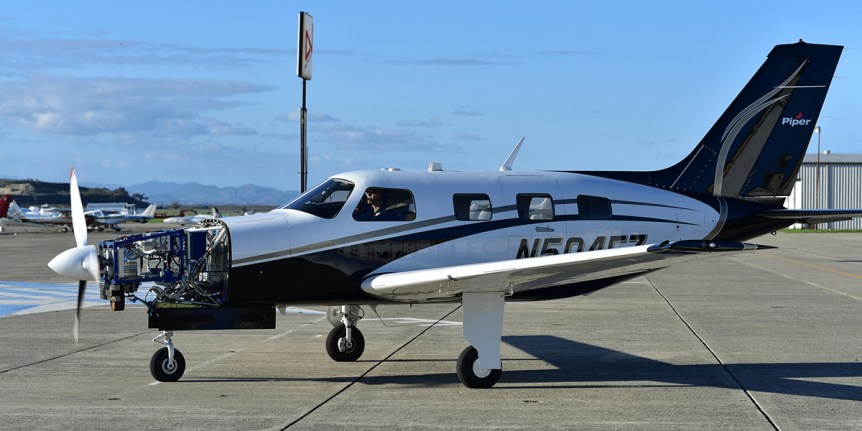China has flown its first hydrogen-powered four-seat aircraft, the Liaoning Ruixiang RX4HE, on March 25. The airplane is somewhat unique in having an internal combustion engine (ICE) that runs on the liquid hydrogen used as fuel. Developed with the FAW (First Automobile Works), the engine displaces two liters and runs on the 4.5 kilograms (9.9 pounds) of highly-pressurized H2 carried on board. This enables one hour endurance at a cruising speed of 180 kilometers per hour (112 mph). FAW claims 43-percent efficiency for the powertrain and an overall thermal efficiency “greater than 40 percent.” (The video shows the RX4E, no videos of the HE model yet available.) According to Wikipedia, “China FAW Group Corp., Ltd. is a Chinese state-owned automobile manufacturer headquartered in Changchun, Jilin. Founded in 1953, it is currently the second largest of the “Big Four” state-owned car manufacturers of China, together with SAIC Motor, Dongfeng Motor Corporation and Changan Automobile.” e-Flight Journal reports the engine is “turbocharged …
Cranfield: Hub of Electric Aviation
Cranfield, England and its local university are hubs for electric aircraft development. Dr. Guy Gratton is test flying The Light Aircraft Company’s eKub on 48-Volt battery power, ZeroAvia is crafting a Dornier 228 to run on hydrogen, and now Cranfied Aerospace Solutions (CAeS) is readying a Britten-Norman Islander for H2-powered flight in 2023. The Islander Living up to its name, Britten-Norman’s Islander seems to be busy worldwide island hopping. The twin-engine plane ever makes the world’s shortest scheduled flights, including this between Juist to Norden across the Wadden See. The 74-second flight is less than the time spent taxiing at the beginning and end of the hop. Designed and developed in the 1960s, 750 Islanders of the 1,280 built are in service with many small airlines and over 30 militaries. Now, other enterprises are banding together with Britten-Norman and Cranfield Aerospace Solutions (CAeS) to bring hydrogen flight to the Isles of Scilly, a popular English vacation destination. Three companies signed …
Regenerative Gas Turbines for Hybrid Aircraft
Beth Stanton shared an email she received from Alex Kovnat, EAA #452346, telling of Turbotech S. A. S., “A startup company” making very efficient gas turbines. Turbotech “has patented a regenerative, high-temperature heat exchanger that increases the efficiency of low power turbines by a factor of 2–3. They achieved this by recycling what would normally be waste heat in the exhaust gases to preheat the air entering the combustor, resulting in less fuel required to generate the same amount of power. Turbotech views the turbogenerator as the ‘missing link”’ that will enable the future of hybrid-electric aeronautical propulsion.” This regenerative ability reduces the amount of fossil fuel required to make things work – a valuable criterion while we await better batteries and cheaper fuel cells. The French company makes both a small turboprop engine, looking very much like “A downsized version of the AGT-1500 regenerative gas turbine that has served since the 1980’s as the power plant for the Army’s …
ZeroAvia Counts on Hydrogen
Tucked away in the quiet little airport at Hollister, California, ZeroAvia has stealthily been developing a hydrogen-powered Piper Malibu, and flying it for the last six months. It sounds like a regular aircraft taking off and passing overhead, even with its two 130 kilowatt (174.26 horsepower) electric motors. ZeroAvia claims 275 kW (369 hp) for the pair. From the videos, propeller noise seems to be much the same as a conventional, internal-combustion powered Malibu, but lacks the added noise of the engine. Piper M-series aircraft are normally powered by a Teledyne Continental Motors TSIO-520BE engine rated at 310 hp (230 kW). Valery Miftakhov, ZeroAvia’s founder and CEO announced, “Right now we have an aircraft that’s six seats and 2 tons as an R&D demonstrator. Next year we’ll have a 20-seat aircraft and we’ll submit the design for [Federal Aviation Administration (FAA)] certification. That’s what drives the 2022, 2023 timeline. At that point, we’re expecting to have certification and put the …
Phantom Eye Flies, Breaks a Leg
Boeing’s Phantom Eye, hydrogen-powered HALE (High Altitude Long Endurance) surveillance aircraft rose from its launch cart at 6:22 a.m. Pacific time on June 1, then climbed to an altitude of 4,080 feet on its 28 minute maiden flight. Phantom Eye is meant to be an autonomous craft with four-day mission capabilities. The bulbous front fuselage houses two spherical hydrogen tanks that feed the Ford 2.3 liter engines on the 150-foot, high-aspect ratio wings. The engines, triple turbocharged at altitude, emit only water vapor, making spying a little cleaner. Note the web-like spinning of carbon fiber strands making up the fuselage. This highly-automated manufacturing process probably emulates that used on the company’s 787 Dreamliner and reflects the high-technology methods we can expect in the future. Phantom Eye’s landing was not quite as elegant as its takeoff, one landing gear breaking after digging into the Edwards Air Force base lakebed. Despite the glitch, Boeing remained upbeat about its new bird. “This day …
Boeing’s PhantomEye Powers Up
While AeroVironment’s Global Observer High Altitude Long Endurance aircraft has flown at the NASA Dryden Flight Test Center, Boeing’s PhantomEye HALE is in pieces but undergoing testing prior to being shipped to Dryden. PhantomEye’s hydrogen-fueled engines are being tested at Santa Clarita, California and airframe parts are being prepared for flight at Boeing’s St. Louis, Missouri plant. AeroVironment’s craft has now flown with fuel cells providing electricity to run the four wing-mounted motors. PhantomEye uses hydrogen stored in eight-foot diameter tanks in its fuselage to directly fuel the twin Ford 2.3-liter modified engines. At altitude, a three-stage turbocharger will be required to provide air for an efficient fuel burn. Both unmanned aerial vehicles have similar missions, to fly at 65,000 feet for up to a week at a time while providing surveillance, monitoring, and communication for military and civilian applications.
Flying High on Hydrogen
AeroVironment announced that their Global Observer™ reached an altitude of 5,000 feet (mean sea level) over Edwards Air Force Base and stayed up for four hours – all on its hydrogen-powered electric motors. Having made its first flights last August and September on battery power, the Global Observer on January 11, 2011 successfully demonstrated the system that will allow it to stay airborne for up to a week at a time, staying on station at 65,000 feet. This ability to maintain “persistent” communications and surveillance enables to the Global Observer to be flown in from areas remote from a combat theater or natural disaster location, and to uninterrupted observation of the situation. AeroVironment claims that, “Two Global Observer aircraft, each flying for up to a week at a time, will alternate coverage over any area on the earth, providing a seamless, persistent platform for high value missions such as communications relay, remote sensing, long-term surveillance and border patrol. Offering greater …
It Only Looks Fat
Aviation Week reports on the inner workings of Boeing’s Phantom Eye HALE (High Altitude Long Endurance) unmanned aerial vehicle. The craft, now being tested at NASA Dryden Flight Test Center at Edwards Air Force Base, has a rotund character that shows form does follow function. Wrapping two eight-foot diameter hydrogen tanks in a low-drag pod and boom style fuselage, the “bulbous” but aerodynamic shape seems at variance with its sailplane-like 150-foot wings. Overall, the design’s unlikely look conceals its purpose as well as its enormous fuel tanks. According to Aviation Week, “Boeing’s objective is a production HALE UAV [unmanned aerial vehicle] with an endurance of 10 days, which would enable it to remain on station for four days at 10,000nm [nautical miles] range, or six days at 6,000nm. Three such air vehicles would be able to maintain continuous surveillance anywhere on Earth, [Boeing Phantom Works’ Keith] Monteith says, for a dramatic reduction in cost compared with today’s 24- to 36h-endurance UAVs.” With …




